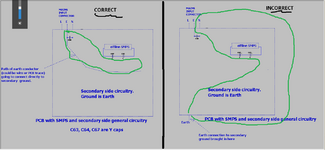cupoftea
Advanced Member level 5
If you earth the isolated secondary of an offline smps, can you confirm that an earth connection to the secondary, must come from the earth wire in the mains cable that supplies the smps?
Also, that the smps must feature y caps from live and neutral to earth, as well as a y cap across the smps isolation barrier?
Also, that the "earth loop" that runs through the y caps across the transformer (across the isolation barrier) and also through the earth connection that runs across the isolation barrier of the smps, (to secondary ground) must be as narrow in area as possible?
Also, that the smps must feature y caps from live and neutral to earth, as well as a y cap across the smps isolation barrier?
Also, that the "earth loop" that runs through the y caps across the transformer (across the isolation barrier) and also through the earth connection that runs across the isolation barrier of the smps, (to secondary ground) must be as narrow in area as possible?
